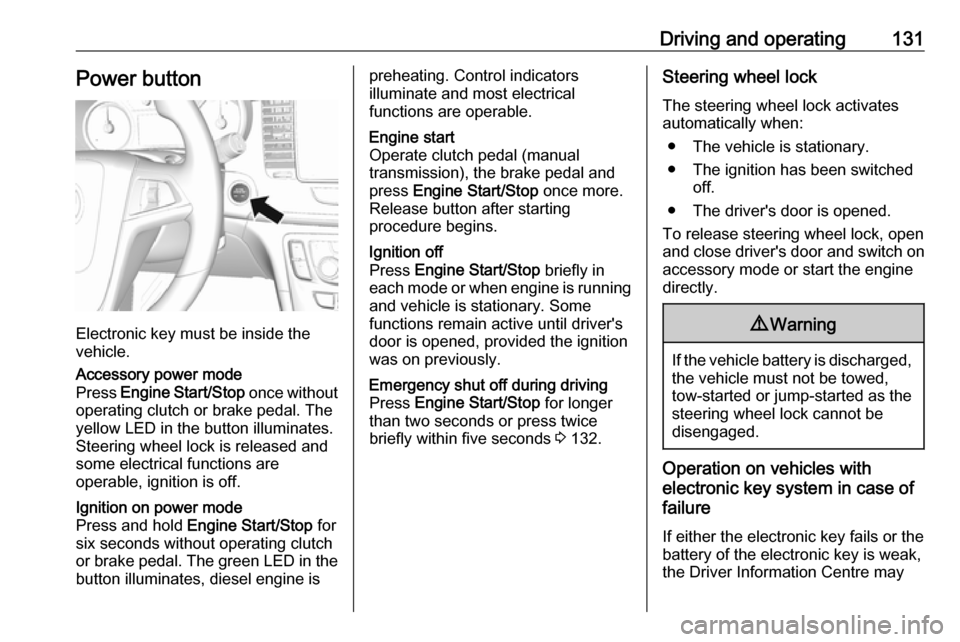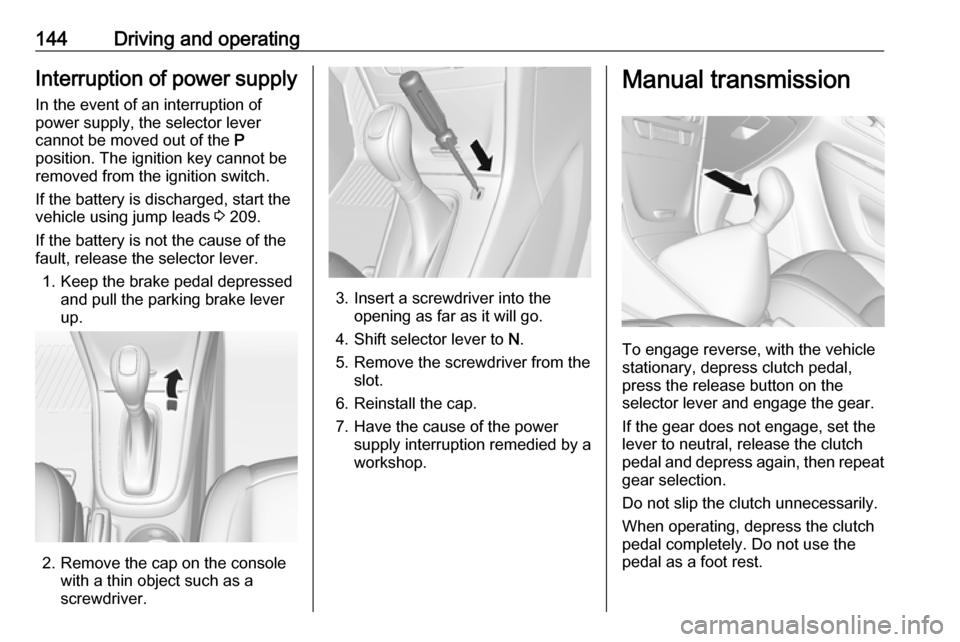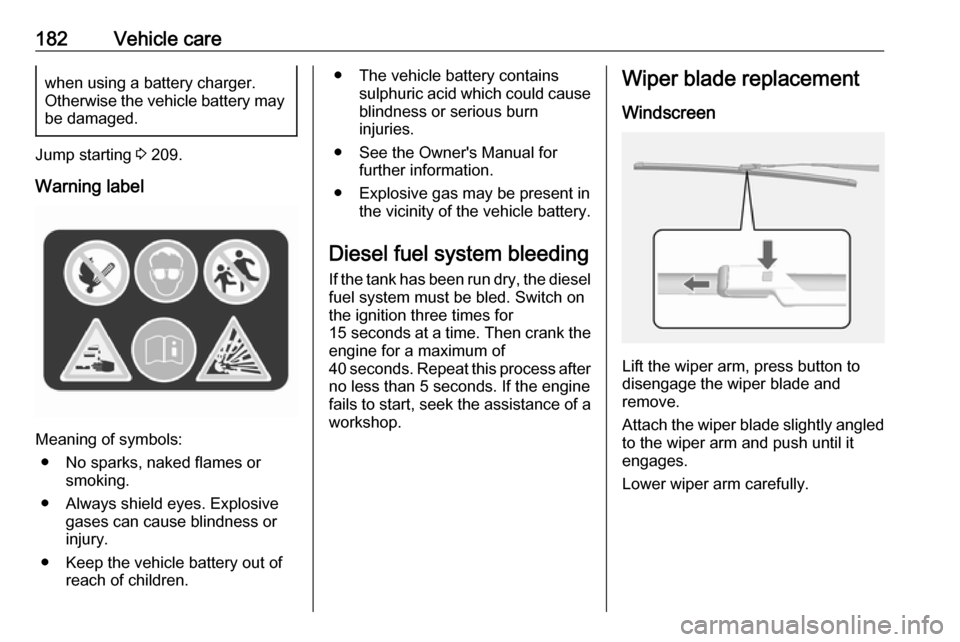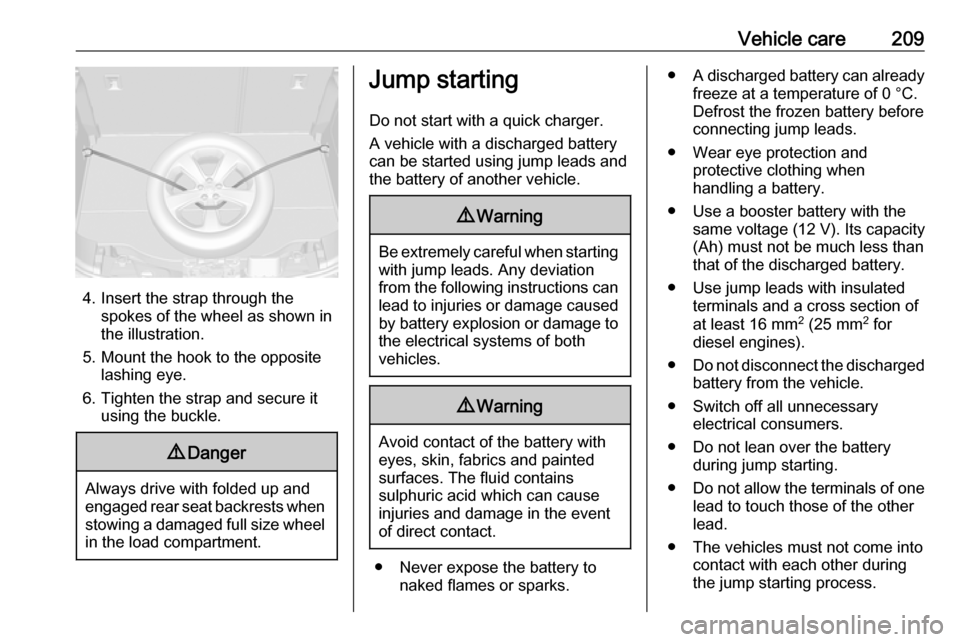jump start OPEL MOKKA X 2019.5 Manual user
[x] Cancel search | Manufacturer: OPEL, Model Year: 2019.5, Model line: MOKKA X, Model: OPEL MOKKA X 2019.5Pages: 247, PDF Size: 6.86 MB
Page 133 of 247

Driving and operating131Power button
Electronic key must be inside the
vehicle.
Accessory power mode
Press Engine Start/Stop once without
operating clutch or brake pedal. The yellow LED in the button illuminates.
Steering wheel lock is released and
some electrical functions are
operable, ignition is off.Ignition on power mode
Press and hold Engine Start/Stop for
six seconds without operating clutch
or brake pedal. The green LED in the button illuminates, diesel engine ispreheating. Control indicators
illuminate and most electrical
functions are operable.Engine start
Operate clutch pedal (manual
transmission), the brake pedal and
press Engine Start/Stop once more.
Release button after starting
procedure begins.Ignition off
Press Engine Start/Stop briefly in
each mode or when engine is running and vehicle is stationary. Some
functions remain active until driver's
door is opened, provided the ignition
was on previously.Emergency shut off during driving
Press Engine Start/Stop for longer
than two seconds or press twice
briefly within five seconds 3 132.Steering wheel lock
The steering wheel lock activates
automatically when:
● The vehicle is stationary.
● The ignition has been switched off.
● The driver's door is opened.
To release steering wheel lock, open
and close driver's door and switch on accessory mode or start the engine
directly.9 Warning
If the vehicle battery is discharged,
the vehicle must not be towed,
tow-started or jump-started as the
steering wheel lock cannot be
disengaged.
Operation on vehicles with
electronic key system in case of
failure
If either the electronic key fails or the
battery of the electronic key is weak,
the Driver Information Centre may
Page 146 of 247

144Driving and operatingInterruption of power supplyIn the event of an interruption of
power supply, the selector lever
cannot be moved out of the P
position. The ignition key cannot be removed from the ignition switch.
If the battery is discharged, start the
vehicle using jump leads 3 209.
If the battery is not the cause of the
fault, release the selector lever.
1. Keep the brake pedal depressed and pull the parking brake lever
up.
2. Remove the cap on the console with a thin object such as ascrewdriver.
3. Insert a screwdriver into the opening as far as it will go.
4. Shift selector lever to N.
5. Remove the screwdriver from the slot.
6. Reinstall the cap.
7. Have the cause of the power supply interruption remedied by a
workshop.
Manual transmission
To engage reverse, with the vehicle
stationary, depress clutch pedal,
press the release button on the
selector lever and engage the gear.
If the gear does not engage, set the
lever to neutral, release the clutch
pedal and depress again, then repeat
gear selection.
Do not slip the clutch unnecessarily.
When operating, depress the clutch
pedal completely. Do not use the
pedal as a foot rest.
Page 177 of 247

Vehicle care175Vehicle careGeneral Information...................175
Accessories and vehicle modifications .......................... 175
Vehicle storage ........................176
End-of-life vehicle recovery .....176
Vehicle checks ........................... 177
Performing work ......................177
Bonnet ..................................... 177
Engine oil ................................. 178
Engine coolant ......................... 179
Power steering fluid .................179
Washer fluid ............................ 180
Brakes ..................................... 180
Brake fluid ............................... 180
Vehicle battery ......................... 181
Diesel fuel system bleeding .....182
Wiper blade replacement ........182
Bulb replacement .......................183
Halogen headlights ..................184
Front fog lights ......................... 185
Tail lights ................................. 186
Number plate light ...................187
Rear fog light ........................... 187
Electrical system ........................188
Fuses ....................................... 188Engine compartment fuse box . 189
Instrument panel fuse box .......190
Load compartment fuse box ....192
Vehicle tools .............................. 194
Tools ........................................ 194
Wheels and tyres .......................194
Winter tyres ............................. 194
Tyre designations ....................195
Tyre pressure .......................... 195
Tyre pressure monitoring system .................................... 196
Tread depth ............................. 200
Changing tyre and wheel size . 201
Wheel covers ........................... 201
Tyre chains .............................. 201
Tyre repair kit .......................... 202
Wheel changing .......................205
Spare wheel ............................ 206
Jump starting ............................. 209
Towing ....................................... 211
Towing the vehicle ...................211
Towing another vehicle ...........212
Appearance care .......................213
Exterior care ............................ 213
Interior care ............................. 215General Information
Accessories and vehicle modifications
We recommend the use of genuine
parts and accessories and factory
approved parts specific for your
vehicle type. We cannot assess or
guarantee reliability of other products
- even if they have a regulatory or
otherwise granted approval.
Any modification, conversion or other
changes made to standard vehicle
specifications (including, without
limitation, software modifications,
modifications of the electronic control units) may invalidate the warrantyoffered by Opel. Furthermore, such
changes may affect driver assistance
systems, fuel consumption, CO 2
emissions and other emissions of the
vehicle. They may also invalidate the
vehicle operating permit.
Page 184 of 247

182Vehicle carewhen using a battery charger.
Otherwise the vehicle battery may be damaged.
Jump starting 3 209.
Warning label
Meaning of symbols: ● No sparks, naked flames or smoking.
● Always shield eyes. Explosive gases can cause blindness or
injury.
● Keep the vehicle battery out of reach of children.
● The vehicle battery containssulphuric acid which could cause
blindness or serious burn
injuries.
● See the Owner's Manual for further information.
● Explosive gas may be present in the vicinity of the vehicle battery.
Diesel fuel system bleeding If the tank has been run dry, the diesel
fuel system must be bled. Switch on
the ignition three times for
15 seconds at a time. Then crank the
engine for a maximum of 40 seconds. Repeat this process after
no less than 5 seconds. If the engine fails to start, seek the assistance of a
workshop.Wiper blade replacement
Windscreen
Lift the wiper arm, press button to
disengage the wiper blade and
remove.
Attach the wiper blade slightly angled
to the wiper arm and push until it
engages.
Lower wiper arm carefully.
Page 211 of 247

Vehicle care209
4. Insert the strap through thespokes of the wheel as shown in
the illustration.
5. Mount the hook to the opposite lashing eye.
6. Tighten the strap and secure it using the buckle.
9 Danger
Always drive with folded up and
engaged rear seat backrests when stowing a damaged full size wheel
in the load compartment.
Jump starting
Do not start with a quick charger.
A vehicle with a discharged battery
can be started using jump leads and the battery of another vehicle.9 Warning
Be extremely careful when starting
with jump leads. Any deviation
from the following instructions can
lead to injuries or damage caused
by battery explosion or damage to the electrical systems of both
vehicles.
9 Warning
Avoid contact of the battery with
eyes, skin, fabrics and painted
surfaces. The fluid contains
sulphuric acid which can cause
injuries and damage in the event
of direct contact.
● Never expose the battery to naked flames or sparks.
●A discharged battery can already
freeze at a temperature of 0 °C.
Defrost the frozen battery before
connecting jump leads.
● Wear eye protection and protective clothing when
handling a battery.
● Use a booster battery with the same voltage (12 V). Its capacity
(Ah) must not be much less than
that of the discharged battery.
● Use jump leads with insulated terminals and a cross section of
at least 16 mm 2
(25 mm 2
for
diesel engines).
● Do not disconnect the discharged
battery from the vehicle.
● Switch off all unnecessary electrical consumers.
● Do not lean over the battery during jump starting.
● Do not allow the terminals of one
lead to touch those of the other
lead.
● The vehicles must not come into contact with each other during
the jump starting process.
Page 212 of 247

210Vehicle care● Apply the parking brake,transmission in neutral,
automatic transmission in P.
● Open the positive terminal protection caps of both batteries.
Lead connection order:
1. Connect the red lead to the positive terminal of the booster
battery.
2. Connect the other end of the red lead to the positive terminal of the
discharged battery.
3. Connect the black lead to the negative terminal of the booster
battery.
4. Connect the other end of the black
lead to a vehicle grounding point,
such as the engine block or an
engine mounting bolt. Connect as far away from the discharged
battery as possible, however at
least 60 cm.
Route the leads so that they cannot
catch on rotating parts in the engine
compartment.
To start the engine: 1. Start the engine of the vehicle providing the jump.
2. After 5 min, start the other engine.
Start attempts should be made for
no longer than 15 s at an interval
of 1 min.
3. Allow both engines to idle for approx. three minutes with the
leads connected.4. Switch on electrical consumers (e.g. headlights, heated rear
window) of the vehicle receiving
the jump start.
5. Reverse above sequence exactly when removing leads.
Page 244 of 247

242Heated rear window ..................... 37
Heated steering wheel .................77
Heating ........................................ 43
Heating and ventilation system . 122
High beam ........................... 96, 112
High beam assist ..................96, 113
Hill start assist ........................... 147
Horn ....................................... 14, 78
I
Identification plate .....................219
Ignition switch positions .............130
Immobiliser ............................ 32, 96
Indicators ...................................... 84
Info Display ................................. 102
Information displays...................... 97
Initial drive information.................... 6
Instrument panel fuse box .........190
Instrument panel illumination control .................................... 119
Instrument panel overview ........... 10
Interior care ............................... 215
Interior lighting ............................ 119
Interior lights .............................. 119
Interior mirrors .............................. 34
Interruption of power supply ......144
Introduction .................................... 3
J
Jump starting ............................. 209K
Key, memorised settings ..............25
Keys ............................................. 21
Keys, locks ................................... 21
L
Lane departure warning .......94, 163
Lashing eyes ............................... 73
Lighting features .........................120
Light switch ................................ 111
Load compartment ................30, 71
Load compartment cover .............72
Load compartment fuse box ......192
Loading information .....................74
Low fuel ....................................... 95
LPG .............................. 86, 166, 221
M Malfunction indicator light ............93
Manual anti-dazzle ......................34
Manual mode ............................. 143
Manual transmission .................. 144
Manual windows ..........................35
Memorised settings ......................25
Midlevel display ............................ 97
Mirror adjustment ........................... 8
Misted light covers .....................119
N New vehicle running-in ..............129
Number plate light .....................187O
Object detection systems ...........156
Odometer ..................................... 84
Oil, engine .......................... 217, 221
Outside temperature ....................80
Overrun cut-off ........................... 134
P Parking ................................ 19, 136
Parking assist ............................ 156
Parking brake ............................ 146
Particulate filter ........................... 137
Performance .............................. 226
Performing work ........................177
Power button .............................. 131
Power outlets ............................... 83
Power steering fluid ....................179
Power windows ............................ 35
Preheating ................................... 95
Puncture ..................................... 205
R Radio Frequency Identification (RFID) ..................................... 239
Radio remote control ...................22
REACH ....................................... 234
Reading lights ............................ 120
Rear carrier system ......................61
Rear floor storage cover ..............73
Rear fog light ...............96, 118, 187
Rear view camera ...................... 158